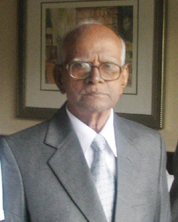
P.R. Srinivasan
|
He was primarily responsible for the establishment of the National Art Gallery in the Madras Government Museum in 1951 which was inaugurated by Pandit Jawaharlal Nehru. He was in charge of organising the Archaeology and Art exhibition in 1951 during the Centenary Celebrations of the Madras Government Museum which was also inaugurated by Pandit Nehru. The credit for organising the 2500th Buddha Jayanthi celebration exhibition in the same museum in 1956, inaugurated by the first President of India, Dr. Rajendra Prasad, goes mainly to him. He was the Founder of the prestigious journal Transactions of the Archaelogical Society of South India, first published in 1954, and was its editor for a number of years. The Archaeological Survey of India (ASI) appointed him as the Special Expert to advise the Committee of the ASI in deciding the antiquity of ancient coins, sculptures, paintings and artifacts.
These and many, many more were the achievements of art-historian and epigraphist P.R. Srinivasan, who was also very well-versed in temple architecture. Born on June 27, 1920, he completed his M.A. in Sanskrit, Indian Culture and Philology from Annamalai University. He later served as the Curator for Archaeology and Art at the Government Museum, Madras, from 1946 to 1959 and was promoted to the position of the Assistant Director. He worked as Special Officer of the ASI during 1959-1960 and, subsequently, served as Lecturer in Historical Archaeology, Indian Art and Architecture at Lucknow University. PRS, as he was affectionately called, later became the Director of the Epigraphy Department of the ASI in 1976 and retired in 1978. Post retirement, he was appointed Special Senior Epigraphist of the French Institute of Indology in Pondicherry till 1986.
PRS had the opportunity to assist the world-renowned art-historian C. Sivaramamurti, who was his predecessor in the Madras Museum as Curator for Art and Archaeology, in establishing the National Museum in New Delhi which was formed with exhibits from many museums in India. He also assisted the eminent historian Professor K.A. Nilakanta Sastri with his magnum opus The Colas, with due acknowledgement by the latter in his preface to the second edition dated 1955 thanking him for "undertaking the detailed description of the illustrations" in the book.
Iowa State University, U.S.A., invited this distinguished scholar to serve as Visiting Professor in History of Indian Art and Historical Archaeology 1967-68. He also delivered lectures on Indian Archaeology and Art in several institutions in the U.S.A. such as Yale University and Texas University. The Art Purchase Committee of the Government of Madras, which included eminent art critics like J.H. Cousins and G. Venkatachalam and the renowned sculptor Devi Prasad Roy Chowdhury, sought his help in purchasing works of art for the National Art Gallery of Madras.
The list of this art-historian's publications is long. Some of them are Guide to the Organisation of Exhibits in a Museum, Buddhist Antiquities in the Madras Museum, Beginnings of South Indian Temple Architecture, Bronzes of South India, Tiruvannamalai – A Saiva Sacred Complex of South India and A Guide Book on Ellora (World Heritage Series). Some of the volumes in the famous series on inscriptions, Epigraphia Indica and South Indian Inscriptions, were edited by him. The Story of Buddhism with Special Reference to South India was co-authored with Dr.A.Ayyappan, Superintendent, Madras Museum, when P.R. Srinivasan was the Curator for Art and Archaeology. This book was released at the 2500th Buddha Jayanthi celebrations in 1956. In addition, numerous articles of his were published in several international and Indian journals of repute.
His magnum opus, Bronzes of South India, was published in 1963 as a Bulletin of the Madras Museum. Profusely illustrated with photographs, it is a very detailed study of the metal images of the Pallava, Chola, Pandya, Vijayanagara, Kerala and folk styles, many of which are in the Egmore Museum. Dedicated to Dr. Sarvepalli Radhakrishnan, the author states in his Preface that he undertook "a systematic study of this subject in order to remove some of the difficulties that exist for a proper appreciation of the art and for a just evaluation of individual specimens."
Remarkable was his service indeed to the fields of art-history and epigraphy.
|